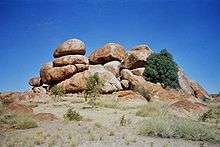Kaytetye
- This article is for the Indigenous Australian group. For their language, see Kaytetye language.

Kaytetye is the name of the language and of the Indigenous Australians who live around Barrow Creek and Tennant Creek in the Northern Territory. Their neighbours to the east are the Alyawarre, to the south the Anmatyerre, to the west the Warlpiri, and to the north the Warumungu. Kaytetye country is dissected by the Stuart Highway.
The Devils Marbles, which the Kaytetye call Karlu Karlu, are located on a sacred Dreaming site. The Kaytetye believe the boulders are the eggs of the rainbow serpent, who passed through the area in the Dreamtime.
The Kaytetye language, like many Indigenous languages in this part of Central Australia, is an Arandic language. Kaytetye language is considered to be a threatened language.[1] A sophisticated form of sign language is also used by some Kaytetye.
The Kaytetye people have existed in this location for longer than outsiders have documented. It was in the 1870s that the Kaytetye would have first encountered Europeans. By the early 1870s, after John Stuart's party navigated the land for the installation of the Overland Telegraph, Kaytetye country and people were, and continue to be, affected by white settlers and their livestock.[2] Pastoralism remains a key feature of Kaytetye country.
Unfortunately, the two cultures did not initially integrate peacefully, however after the 1890s Kaytetye confrontations with whites were rare.[3] In 1874, European settlers stationed at the Barrow Creek telegraph station broke tribal laws, provoking an attack by some Kaytetye men. This sparked revenge killings of Kayetye by the settlers who had different understanding of 'the law'.[4][5] Later, in the widely known Coniston massacre of 1928, a series of punitive raids occurred over a number of weeks as police parties killed indiscriminately.[6] The retribution posse killed Kaytetye people, even though the Kaytetye were not part of the offending transgression.[7]
Kaytetye people worked alongside European settlers for years to come in pastoral and mining capacities but were not treated equally until the period of World War 2 in which an army settlement was established near Barrow Creek.[8] Many Kaytetye men and women were employed and were treated fairly for the first time, making it difficult for pastoral stations to keep their Indigenous workers on the station. This forced a change the way Kaytetye pastoral workers were treated.[9] Both the mining employment and the army settlement were temporary engagements, leaving the Kaytetye only pastoral work if they desired to stay in their country.
Kaytetye call the area around Barrow Creek Thangkenharenge which includes the site of their creation story at Elkerempelkere.[10] Traditionally, the Kaytetye people maintain their connection to the sacred sites like Elkerempelkere.
Alternative spellings for Kaytetye include Kartetye, Kartiji, Kaytej, Keytej and Katish.
References
- ↑ Ethnologue: Languages of the World https://www.ethnologue.com/language/gbb. Retrieved 6 June 2015. Missing or empty
|title=(help) - ↑ Koch, G. 1993, Kaytetye Country, Institute for Aboriginal Development, Alice Springs, p xiv
- ↑ Koch, G. 1993, Kaytetye Country, Institute for Aboriginal Development, Alice Springs, p xvii
- ↑ McEvoy, P., Lyon, P. 1994, The Land Is Always Alive: the Story of the Central Land Council, Central Land Council, p. 88
- ↑ Hartwig, as quoted by Koch, G. 1993, Kaytetye Country, Institute for Aboriginal Development, Alice Springs, pxv
- ↑ http://notes.nt.gov.au/lant/hansard/hansard9.nsf/0/1268da845704358869256de80027785b
- ↑ http://www.clc.org.au/publications/content/making-peace-with-the-past-remembering-the-coniston-massacre-1928-2003
- ↑ Berndt, C.H., Berndt, R.M. 1987, End of an Era, Aboriginal Labour in the Northern Territory, Australian Institute of Aboriginal Studies, Canberra, p 177
- ↑ http://www.clc.org.au/media/releases/2002/aug02_barrowck.asp
- ↑ Turpin/Thompson, Myf/Tommy (2003). Growing up Kaytetye (1st ed.). Alice Springs: Institute for Aboriginal Development. pp. 3–5.
External links
- "Barrow Creek", Central Land Council